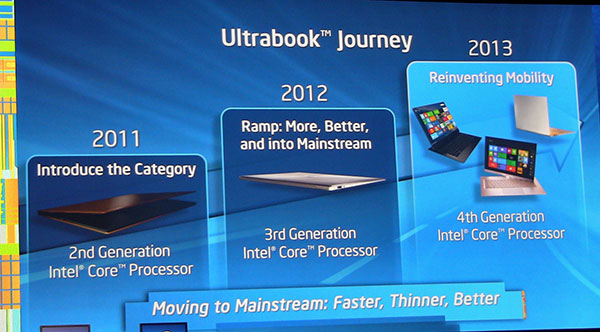IDF Day 1: Haswell Live Graphics Demo
Intel Haswell 4th Gen Core Graphics at IDF
Intel’s Dadi (David) Perlmutter, General Manager Intel Architecture Group and Chief Product Officer, opened up the 2012 Intel Developers Forum by reflecting back on the significance of this day, the eleventh anniversary of the attacks on 9/11. Today, however, also marks the fifteenth anniversary of IDF, so Dadi ultimately moved on to a quick overview of the many advances and innovations that have taken place at Intel since the event began in 1997. Perlmutter showed off a Medfield SoC alongside a Xeon Phi, along with a number of Intel Atom and Core powered Windows 8 tablets and Ultrabooks, but he finished with a couple of live demos showing the company’s upcoming Haswell-based 4th Gen Core Processors in action.

We’ve disclosed a number of details regarding Haswell already, some dating all the way back to last year’s IDF. More recently though, we posted this piece outlining some architectural details and power targets of the upcoming microarchitecture. The goal during Haswell’s design phase was to not only increase performance per watt, but to do so while improving power efficiency by roughly 20x with some workloads, through architectural enhancements, manufacturing process innovations, and more efficient overall system/platform design.
The Haswell microarchitecture will be the foundation of an entire family of products when it debuts sometime next year. It will be built using Intel’s 22nm process node and was designed from the start with mobility in mind, but Haswell will eventually power everything from tablets to high-performance servers. Intel’s plan with Haswell was to create a highly scalable design to address virtually every market segment. Haswell, and its associated platform hardware, are scalable with regard to core counts, its graphics configuration, power levels and cache and interconnects. The platform hardware is scalable as well to address many different form factors.

We’ll have more details on Haswell and the 4th Gen Core processor family as we get closer to launch, but want to specifically call out its graphics performance as it pertains to Perlmutter’s opening keynote. Dadi showed off a Haswell-based prototype running the Unigine Heaven benchmark, side by side with an Ivy Bridge-based machine. As you’ll see in our video, the Haswell-based system was able to produce much better framerates. Better performance is only part of the story, though. Haswell’s integrated GPU is not only able to offer roughly double the performance of previous architectures in the same power envelope, but it can also offer similar performance at much lower power. Another part of the demo showed the Haswell-powered system performing at roughly the same level as Intel’s previous-generation on-processor graphics engine, but at only half the power—17 watts versus 8 watts.
Intel is able to achieve much better graphics performance and/or lower power with Haswell through a couple of key innovations. Producing the chips using Intel’s 22nm tri-gate technology has inherent power-related benefits. But Haswell’s GPU is also been tweaked for better performance throughout its pipeline. The GPU is Direct X 11.1, Open CL, and Open GL 4.0 compatible, and will be offered in three configurations—GT1, GT2, and GT3. GT1 and GT2 are similarly configured on the hardware front, but GT3 doubles up on the number of execution units in the GPU.
There will be much more information regarding Haswell in the days, weeks, and months to come. Stay tuned to HH for the scoops as they become available.






